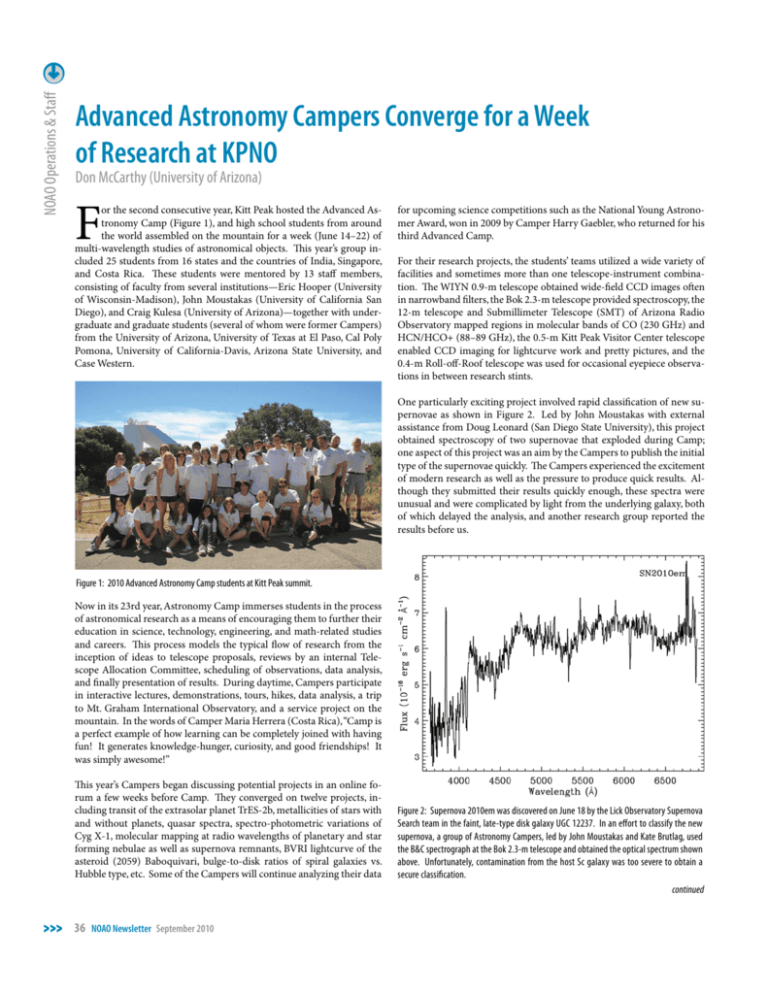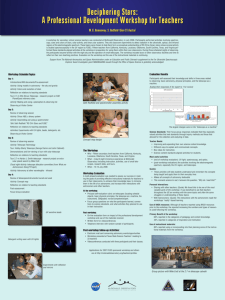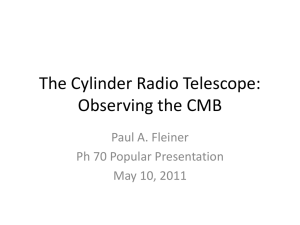Advanced Astronomy Campers Converge for a Week at KPNO
advertisement

NOAO Operations & Staff Advanced Astronomy Campers Converge for a Week of Research at KPNO Don McCarthy (University of Arizona) F or the second consecutive year, Kitt Peak hosted the Advanced Astronomy Camp (Figure 1), and high school students from around the world assembled on the mountain for a week (June 14–22) of multi-wavelength studies of astronomical objects. This year’s group included 25 students from 16 states and the countries of India, Singapore, and Costa Rica. These students were mentored by 13 staff members, consisting of faculty from several institutions—Eric Hooper (University of Wisconsin-Madison), John Moustakas (University of California San Diego), and Craig Kulesa (University of Arizona)—together with undergraduate and graduate students (several of whom were former Campers) from the University of Arizona, University of Texas at El Paso, Cal Poly Pomona, University of California-Davis, Arizona State University, and Case Western. for upcoming science competitions such as the National Young Astronomer Award, won in 2009 by Camper Harry Gaebler, who returned for his third Advanced Camp. For their research projects, the students’ teams utilized a wide variety of facilities and sometimes more than one telescope-instrument combination. The WIYN 0.9-m telescope obtained wide-field CCD images often in narrowband filters, the Bok 2.3-m telescope provided spectroscopy, the 12-m telescope and Submillimeter Telescope (SMT) of Arizona Radio Observatory mapped regions in molecular bands of CO (230 GHz) and HCN/HCO+ (88–89 GHz), the 0.5-m Kitt Peak Visitor Center telescope enabled CCD imaging for lightcurve work and pretty pictures, and the 0.4-m Roll-off-Roof telescope was used for occasional eyepiece observations in between research stints. One particularly exciting project involved rapid classification of new supernovae as shown in Figure 2. Led by John Moustakas with external assistance from Doug Leonard (San Diego State University), this project obtained spectroscopy of two supernovae that exploded during Camp; one aspect of this project was an aim by the Campers to publish the initial type of the supernovae quickly. The Campers experienced the excitement of modern research as well as the pressure to produce quick results. Although they submitted their results quickly enough, these spectra were unusual and were complicated by light from the underlying galaxy, both of which delayed the analysis, and another research group reported the results before us. Figure 1: 2010 Advanced Astronomy Camp students at Kitt Peak summit. Now in its 23rd year, Astronomy Camp immerses students in the process of astronomical research as a means of encouraging them to further their education in science, technology, engineering, and math-related studies and careers. This process models the typical flow of research from the inception of ideas to telescope proposals, reviews by an internal Telescope Allocation Committee, scheduling of observations, data analysis, and finally presentation of results. During daytime, Campers participate in interactive lectures, demonstrations, tours, hikes, data analysis, a trip to Mt. Graham International Observatory, and a service project on the mountain. In the words of Camper Maria Herrera (Costa Rica), “Camp is a perfect example of how learning can be completely joined with having fun! It generates knowledge-hunger, curiosity, and good friendships! It was simply awesome!” This year’s Campers began discussing potential projects in an online forum a few weeks before Camp. They converged on twelve projects, including transit of the extrasolar planet TrES-2b, metallicities of stars with and without planets, quasar spectra, spectro-photometric variations of Cyg X-1, molecular mapping at radio wavelengths of planetary and star forming nebulae as well as supernova remnants, BVRI lightcurve of the asteroid (2059) Baboquivari, bulge-to-disk ratios of spiral galaxies vs. Hubble type, etc. Some of the Campers will continue analyzing their data 36 NOAO Newsletter September 2010 Figure 2: Supernova 2010em was discovered on June 18 by the Lick Observatory Supernova Search team in the faint, late-type disk galaxy UGC 12237. In an effort to classify the new supernova, a group of Astronomy Campers, led by John Moustakas and Kate Brutlag, used the B&C spectrograph at the Bok 2.3-m telescope and obtained the optical spectrum shown above. Unfortunately, contamination from the host Sc galaxy was too severe to obtain a secure classification. continued NOAO Operations & Staff Advanced Astronomy Campers at KPNO continued Another project involved the lightcurve of a near-Earth asteroid: (2059) Baboquivari. Since this object was ~2 magnitudes brighter this year than in 2009, we obtained higher signal-to-noise photometry with the WIYN 0.9-m telescope. Further analysis will characterize the object’s colors and should result in the first taxonomic classification of this object. A movie of the asteroid’s path is posted at zeus.as.arizona.edu/~dmccarthy/ ATC10/baboquivari.mpg. The 0.5-m Advanced Observing Program telescope at the Kitt Peak Visitor Center was used for both research and picture taking to demonstrate principles of image processing. Figure 3 shows a lightcurve of the transit of the hot-Jupiter planet TrES-2b obtained in the z-filter. It is remarkable—and would have been unthinkable only a few years ago—that teenagers using a modest-sized telescope with an (admittedly, high end) amateur CCD camera could detect a transiting planet with an amplitude of 0.02 mag. Figure 4 shows a wide-field image of the North American Nebula (NGC 7000; IC 5067-70) obtained through an H-alpha filter using the Takahasi 106-mm refractor. We are very grateful to operators Steve Peterson and Flynn Haase for being so willing to interact with the students and for their guidance in using the telescope optimally. Figure 4: A wide-field image of the North American and Pelican nebulae (NGC 7000; IC5070) obtained in the emission of hydrogen-alpha. This image was obtained from the Takashi refractor mounted on the Kitt Peak Visitor Center 0.5-m telescope as part of the Advanced Observing Program of KPNO. Figure 5: Sunset viewed via the main beam of the McMath-Pierce Solar Telescope. The dynamic effects of atmospheric refraction and dispersion, airplane transits, and coloration of sunspots provided lessons in basic physics and astronomy. (Image credit: Maria Herrera.) Figure 3: Lightcurve of the transiting, hot-Jupiter planet TrES-2b obtained at the Kitt Peak Visitor Center 0.5-m telescope in a z-band filter. The data gap from 0.3–0.6 hours was caused by repositioning of the telescope at meridian crossing. An unusually fun and educational experience came each night while watching sunset through the main and auxiliary beams of the McMathPierce Solar Telescope. Each observation provided opportunities to discuss a variety of solar and atmospheric phenomena (Figure 5). Also, airplanes were visible as they transited across the Sun, sometimes showing their contrails either during transit or as they egressed the limb. A particularly unexpected phenomenon, first noticed by Camper Zoey Martin-Lockhart, was associated with the chromatic dispersion of the solar image; sunspots displayed the opposite orientation of color separation from the overall solar disk. Counselor Brandon Swift figured out an explanation, which we would be happy to share with anyone interested. Claude Plymate from the National Solar Observatory went out of his way to facilitate our use of the telescope and also provided several in-depth tours of the facility. During the week, Astronomy Campers also interacted with scientists from other institutions, heard an inspirational talk by David Levy at the 2.3-m telescope, merged the science of star formation with organ music during a presentation by graduate student Matthew Whitehouse, splurged in the gift shop, took a daylong trip to Mt. Graham to experience the Large Binocular Telescope and SMT, and enjoyed the long-standing tradition of volleyball on the mountain after removing weeds and dirt from the court as part of a daily service project. We are thankful for the hard work, patience, and gracious support provided by Mike Hawes and his dedicated staff as well as Hillary Mathis, Bob Martino, Dave Murray, Casey Muse, Frederick Ramon, Clay Nuñez, Mike Merrill, Bellina Cancio, Debra McQuiston, Nanette Bird, Elizabeth Alvarez del Castillo, Betsy Green, Bill Wood, Dennis Means, Geno Bechetti, Ron Mastaler, Mike Soukup, and Tom Folkers. Astronomy Camp is sponsored by The University of Arizona Alumni Association and has a Web site at astronomycamp.org. NL NOAO Newsletter September 2010 37



